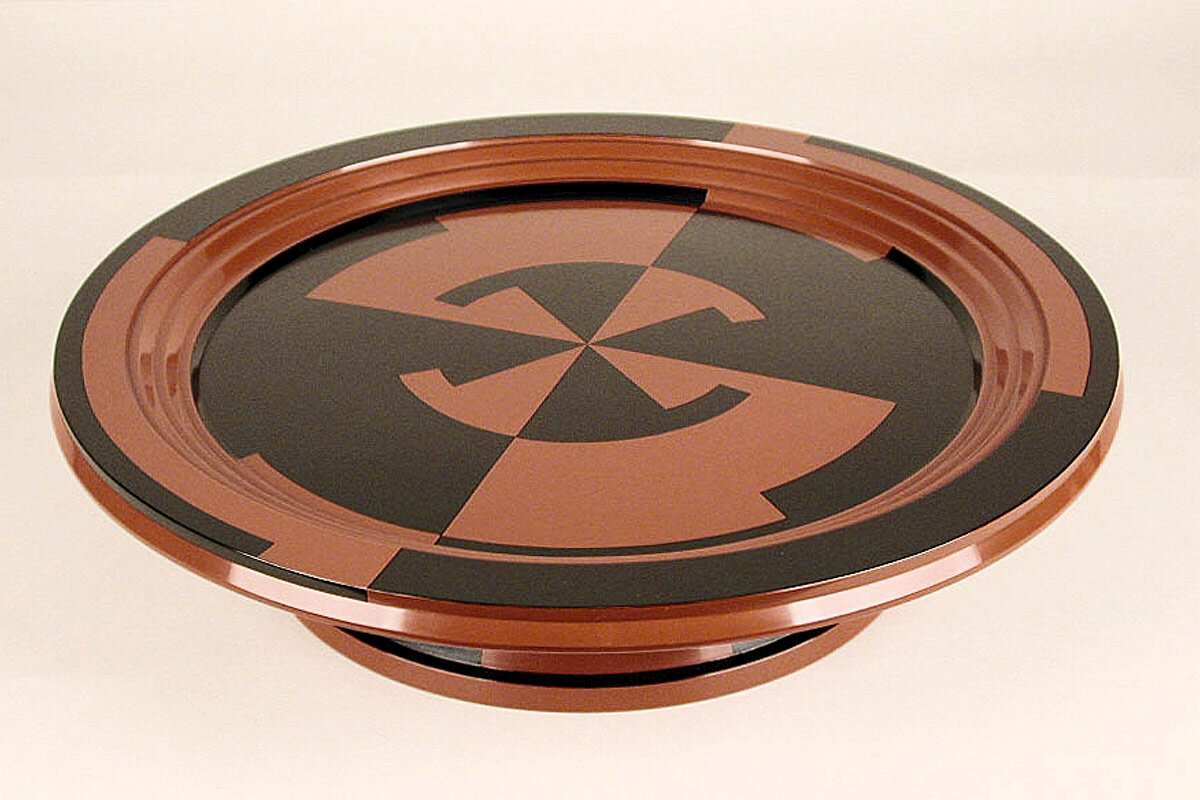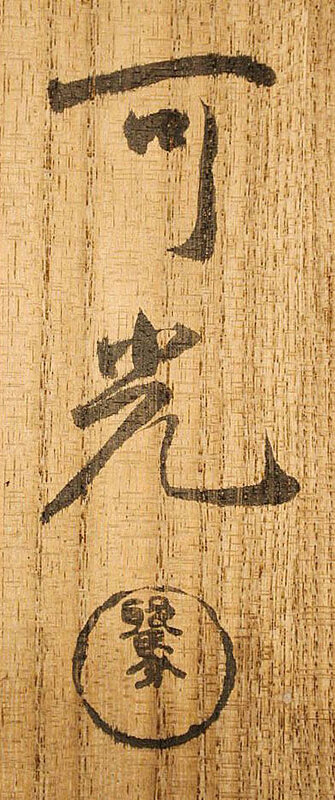ART DECO & MODERNISM
YAMANAGA KAKO, MODERNIST LACQUER INCENSE TRAY
Korobon or tray for displaying an incense burner in a circular form with a flat stepped rim, the pedestal stepped out in the reverse of the rim, the surface ornamented with bold geometric designs. Of black and orange lacquer over a wood base. By Yamanaga Kako (Yamanaga Kako, an early go or art name of Yamanaga Gengo, who later used the go or art name Yamanaga Koho, 1889 – 1973). Early Showa era, circa 1926 – 1935.
With the tomobako or original box, inscribed on the exterior of the lid: Korobon or Incense Burner Tray; and signed: Kako, and sealed.
Yamanaga Koho was born in Yabakei in Oita Prefecture (Kyushu), and studied lacquer at the Beppu Industrial School in Oita Prefecture. After graduating he moved to Tokyo to study under Rokkaku Shisui and Kisaburo Watanabe, Koho met the ceramicist Tomimoto Kenkichi, who was teaching at the Tokyo School of Fine Arts, and in 1948 when Tomimoto moved to Takayama in Gifu Prefecture, he followed him and settled nearby in Gero. Koho exhibited at the Noten in 1924 through 1927, winning the highest prize awarded in 1925 for the work “Cake Bowl, circular-flower-carved design.” He later exhibited at the Shin-Bunten in 1936, 1937, 1938, 1940, 1942, and 1943. In 1937 he helped establish the Japan Academy of Fine Art. After the War he showed at the Nitten in 1946 and 1947. Koho also showed at the Nihon Dento Kogeiten.
Professor Terao of the Kanazawa Prefectural Art Museum dates this korobon from Yamanaga Koho’s innovative Pre-War period, from the late 1920’s to the early 1930’s. According to Professor Terao, Yamanaga Koho spent a few years working in Kanazawa during this period, and it is generally thought that he only used the go of Kako at this time. As was true of a number of artists working in Ishikawa, (Oshita Sekko for example), Yamanaga Kako only signed the storage boxes for his work, and not the pieces themselves. Professor Terao stated that the box calligraphy and signature for this korabon are identical to those on two pieces in the collection of the Kanazawa Prefectural Museum, dating to 1927 and 1931.
For other examples of Yamanaga Koho’s work, c.f. Japanese Lacquer Art: Modern Masterpieces, edited by the National Museum of Modern Art, Tokyo, plates 202, 203, 204, 205, 206, and 207; and another catalogue from the National Museum of Modern Art, Tokyo, Nuances in Lacquer: Seventy Years of Innovations, by Masami Shiraishi, numbers 5,6, 7, 8, 9, and 10.
Yamanaga Koho’s work is in the collections of the National Museum of Modern Art, Tokyo and the Ishikawa Prefectural Museum of Art.
Yamanaga Koho worked in rokkuro or lathe-turned wood ornamented in colored lacquer as here, and in kanshitsu. According to Professor Terao relatively few pieces of his early work are extant. Yamanaga Koho remains famous as one of the most innovative lacquer artists of the early Showa era.
Yamanaga Kako, Modernist Lacquer Incense Tray
Artist Name: Yamanaga Kako
Period: Showa Pre War
Styles: Art Deco, Modernist
Mediums: Lacquer
Form: Trays & Stands
Origin Country: Japan
3-5/8” high x 15-1/2” diameter
This piece is no longer available.



